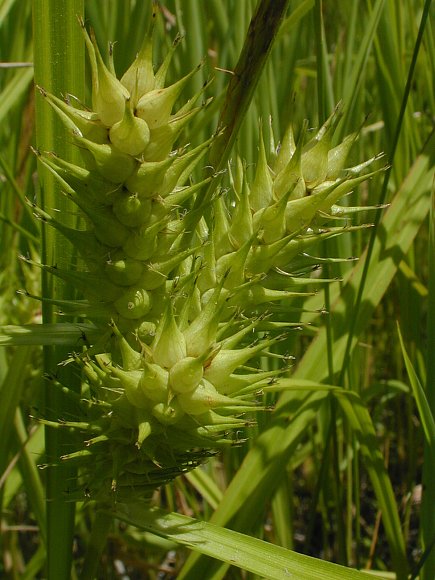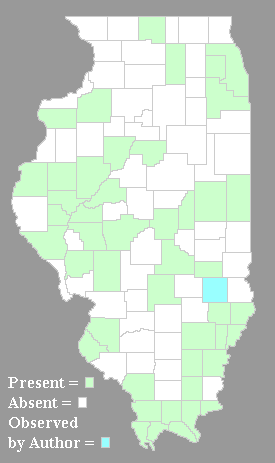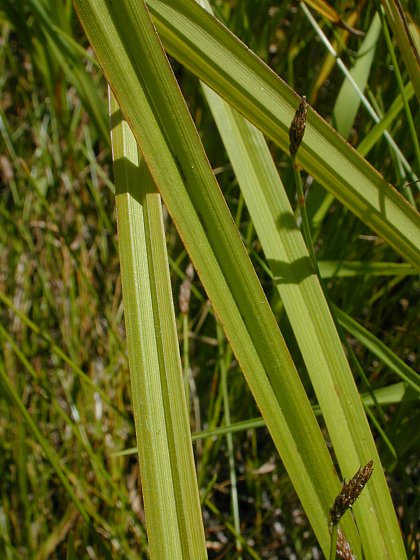Description: This perennial sedge is about 1½–3½' tall, consisting of a tuft of leaves and flowering culms. The erect to ascending culms are light green to green, 3-angled, glabrous, and rather spongy toward the base, becoming more slender at the apex where the inflorescence occurs. Alternate leaves are produced from both fertile and infertile shoots. The leaf blades are up to 2' long and ½" (12 mm.) across; they are light green to green, glabrous, and linear in shape. The leaf blades have a tendency to arch away from their culms; the larger blades are conspicuously furrowed along their central veins. The leaf sheaths are light green, longitudinally veined, and glabrous. The culm of a fertile shoot terminates in an inflorescence consisting of a terminal staminate spikelet (less often 2-3 staminate spikelets) and 2-7 pistillate spikelets. The narrow staminate spikelet is up to 4" long, light to dark brown (after releasing its pollen), and somewhat flattened; it can be nearly sessile, short-stalked, or long-stalked. The pistillate spikelets are up to 3½" long and 1¼" across; they are oblongoid-cylindrical in shape and densely crowded with the inflated perigynia of the pistillate florets. These perigynia are mostly ascending; the lower perigynia are more widely spreading. Initially, the pistillate spikelets are light green to yellowish green, but they become yellowish brown to brown with maturity. The pistillate spikelets usually occur in a loose cluster on short slender peduncles.

The perigynia are
up to 15 mm. (2/3") long and 6 mm. (¼") across; they are
lanceolate-ovoid
in shape, tapering to long narrow beaks. There are several fine
longitudinal veins along the outer surface of each perigynium. The
pistillate scales are smaller in size than the perigynia; they are
lanceolate, tapering gradually into awned tips. Immature
pistillate scales have green central veins and translucent margins;
they become more brown at maturity. The blooming period occurs from
late
spring to mid-summer (rarely later), lasting about 1-2 weeks. The
florets are cross-pollinated by wind. At this
time, each pistillate floret has 3 curly white stigmata that are
exerted
from the beak of its perigynium. About one month after the blooming
period, the inflated perigynia disarticulate from the pistillate
spikelets; they have the capacity to float on water, distributing the
achenes to new areas (there is one achene per perigynium). The achenes
are about 3 mm. long and 3
mm. across; they are hexaploid in shape and sharply angular (shaped
like 6-sided diamond crystals); they are often slightly knobby
where 3 edges meet at lateral corners, and their sides are often slightly concave. The
achenes are glabrous and, depending on their maturity, light green to
brown. At the
apex of each achene, there is a persistent style that is coiled or
curved near its base; this style is longer than the
achene. The root system is fibrous
and rhizomatous. Occasionally, clonal offsets are
produced from the rhizomes.
slightly concave. The
achenes are glabrous and, depending on their maturity, light green to
brown. At the
apex of each achene, there is a persistent style that is coiled or
curved near its base; this style is longer than the
achene. The root system is fibrous
and rhizomatous. Occasionally, clonal offsets are
produced from the rhizomes.
Cultivation:
The preference is light shade to full sun, wet to consistently moist
conditions, and mucky to slightly sandy soil. Occasional
flooding is tolerated,
although not for long periods of time. The leaf blades become a lighter
shade of green in bright sunlight.
Range & Habitat:
The native Hop-like Sedge occurs in widely scattered locations
throughout
Illinois, where it is uncommon. Habitats include wet to moist
areas of bottomland woodlands, swamps, soggy meadows, low areas along
streams, marshes, and roadside ditches. This sedge usually
occurs in wetlands with overhead canopy trees, although
sometimes it can be found in open sunny wetlands. These habitats can be
either sandy or non-sandy. Sometimes this sedge is used in wetland
restorations.
Faunal Associations:
Caterpillars of the butterfly Satyrodes
eurydice (Eyed Brown), caterpillars of various skippers (Euphyes spp., Poanes spp.), and
larvae of various moths feed on wetland sedges (Carex spp.); see
the Lepidoptera Table for a listing of these species. Other insects feeding
on these sedges include
sedge grasshoppers (Stethophyma
spp.), semi-aquatic leaf beetles (especially Plateumaris spp.), Sphenophorus costicollis
(Sedge Billbug) and other billbugs (Sphenophors
spp.), leaf-mining larvae of the fly Hydrellia griseola
(Lesser Rice Leafminer), stem-boring larvae of the flies Cordilura varipes
and Loxocera cylindrica,
the seed bugs Cymus
angustatus and Oedancala
dorsalis, the stink bug Eurygaster alternata,
various aphids, and leafhoppers (especially Cosmotettix spp.).
Among vertebrate animals, the seeds of wetland sedges are eaten by
waterfowl, rails, and some songbirds (see
the Bird
Table for a listing of these species). The muskrat
occasionally feeds on the rhizomes, culms, and young shoots.
Photographic Location:
A restored marsh at the Prairie Ridge State Natural Area in Jasper
County, Illinois.

Comments: This is one of the larger and more attractive sedges (Carex spp.) in Illinois – the large pistillate spikelets have a striking appearance, resembling a spiked-club or similar weapon of medieval warfare. Hop-like Sedge closely resembles Carex lupulina (Hop Sedge), and distinguishing between these two species can be rather difficult. The most reliable method of identification involves an examination of their achenes: Hop-like Sedge has non-flattened hexaploid achenes, while the hexaploid achenes of Hop Sedge are somewhat flattened. In the field, specimens with intermediate characteristics (e.g., with slightly flattened achenes) may be hybrids of the preceding two species. The common names of these sedges refer to the superficial resemblance of their pistillate spikelets to the fruits of Humulus lupulus (Hop Vine). Another common name of Carex lupuliformis is False Hop Sedge.